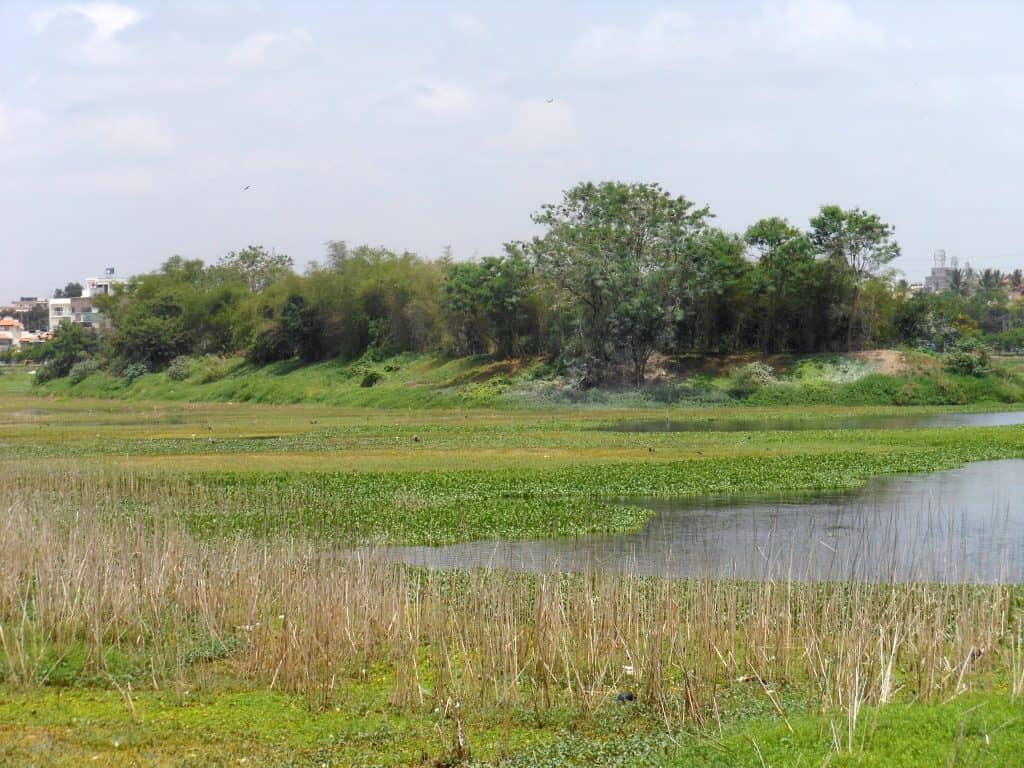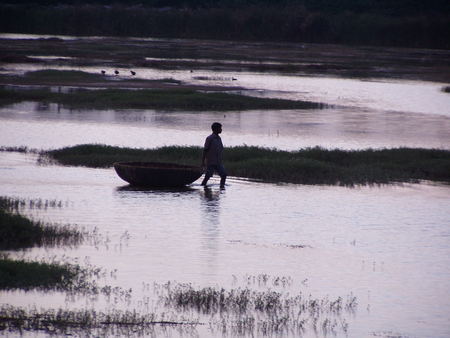Lying between bustling Koramangala and H.S.R. Layout in South Bangalore, Agara lake is a picture of tranquility. Its 39.58 hectares of greenery and water, which attract a variety of birds, make it valuable lung space that many area residents cherish. But, if recent developments are anything to go by, it could be under threat.

Agara lake, one of the prominent and beautiful lake of south Bangalore. Pic: Meera K
Vigilant residents are aghast that this green oasis could soon be turned into an amusement park. The last thing they want is for Agara lake to be lost to big money and pollution. They are determined that they will do all they can to preserve the lake as an area of natural beauty and recreation.
“We don’t want any kind of artificial entertainment here. The lake is beautiful as it is and that’s why people in the area enjoy being there. We will oppose any plans to turn it into an amusement park,” says Mr. Murlidhar Rao, a resident of Koramangala and a member of the Save Koramangala group, vehemently.
Attempt to cleanup
In 2004, the Bangalore Development Authority (BDA), together with the Forest Department, restored the lake and erected a fence around it. But the lack of basic maintenance as well as abuse by residents, rubbish started accumulating. On 1 April 2007, about 50 residents of Koramangala and H S R Layout turned up at Agara Lake. Their objective: to clean up the lake. Men, women and children spent a couple of hours picking up rubbish lying around. Joining their efforts was the Forest Department which arranged for men in coracles to clean up the water.
But now, the Lake Development Authority (LDA) has other plans for the lake. On May 1, 2007 it entered into an agreement with Hyderabad-based Biota Natural Systems Pvt. Ltd. to lease out the lake to the company for 15 years. The company will set up an amusement park around the lake, investing Rs.13 crore in its development and paying Rs.46.80 lakh per annum to the LDA. “Now, very clearly, if Biota has to pay that kind of money, in addition to maintaining the lake, it has to generate minimum revenue levels of Rs. 10 to 12 lakh per month. Of course, the birds will have to find some other place. Is that what we want?” questions Rao. He adds, “If it’s PPP they want, why has the public been left out?”
LDA’s mandate
The Lake Development Authority (LDA) was set up in July 2002 as a “non-profit organisation working solely for the regeneration and conservation of lakes in and around Bangalore.” It is not a statutory authority. It was created by a government order and it is a registered society under the Karnataka Societies Registration Act, 1959. Its stated mission is to rejuvenate, revitalise and restore the dying lakes and protect them against further pollution in order to recharge the depleting ground water and to improve surrounding environs with the help of community participation.

Fishermen at Agara Lake (pic: Meera K)
Dr M Muni Reddy, CEO, LDA says, “We will not allow the company to cross the limits. They will maintain the water body and erect temporary structures for the public’s amusement such as joy rides, swings and slides and even organise some boating. The structures will be erected on 5 per cent of the foreshore area with the rest maintained as greenery. Furthermore, they will go in for engineered wetland development which will replenish the lake’s waters with treated sewage during the summer.”
But concerned residents have shot off a letter to the Chief Secretary, Government of Karnataka, P B Mahishi, who is also chairman of the LDA, objecting to any plans to turn the lake into an amusement park. They wouldn’t want it to go the way of the Nagavara lake, near Hebbal, which is on lease to Lumbini Gardens, a Hyderabad-based company. The residents found that the contrast with Agara lake couldn’t be more glaring. At Nagavara, what was a natural environment has been turned into an artificial playground. They saw diesel leaking from the boats and polluting the water. Though there were waste bins all around, there was plenty of rubbish in the water too. And, one has to pay a fee of Rs.30 to get in, making it inaccessible to those who cannot afford it.
Did the LDA hold a public hearing with citizens before the decision on the project? No. There is no such rule mandating such a hearing. Apparently, jurisdiction over the lakes lies with the LDA, and the LDA merely called for tenders for ‘development’ of the lake.
But the Karnataka State Pollution Control Board has a say and it has weighed on the matter. Any construction near the lake will have to get the approval of the KSPCB. Its chairman, Dr H C Sharatchandra says, “Lakes must be natural preserves with free access to the public. It is a question of equity. Anybody, rich or poor, must be able to enjoy the natural beauty without hindrance.” The project has not gone through the review of the KSPCB yet. The company which takes over the lake will have to apply for clearance from KSPCB.
The Agara lake today attracts a variety of ducks, coots, purple moorhens, grey herons, egrets, kites and kingfishers. Says Zafar Futehally, noted environmentalist and ornithologist, at whose initiative the April 2007 clean-up was undertaken, “One drop of oil can ruin 1 sq. km. of the lake. This lake is an integral part of the ecosystem here. It keeps the area cool, prevents flooding and replenishes the water table. It is essential that it is kept as nature intended it to be and not turned into something artificial. What is required is basic maintenance – cleaning up of the water once in a while and keeping the area rubbish-free.”
Manvel Alur, a Koramangala resident, enjoys her weekend visits to the lake. “It’s lovely going there for walks and bird watching. My children like cycling there too. The lake is valuable lung space that’s close by. We don’t have to go all the way to Cubbon Park. It would be a shame if it is commercialised,” she says.
For the residents of BTM Layout, Madiwala, Koramangala and H S R Layout, the Agara lake is indeed a much needed natural haven. As one watches the ducks swim about and the egrets hunt for fish in the lake’s placid waters, while people stroll about, it is clear that Agara lake must stay the way it is to be enjoyed by the community at large.
Hi,
I am working with Green Commnados, which is a Environmental off-shoot of Youth For Seva (YFS). We are planning to clean up Agara lake and try to impose security to the lake premises to keep away illegal fishing and garbage dumping so that the lake is sustained on a longer run. I am clueless on whom to approach concerning the lake security issues. Any help, pointers would really help.
Thanks,
Aparna V K
Aparna,
Agara lake is in distress.
It could be a prime property if the lake dies. Think about the vested interests of governing bodies involed.
The fight to save the lake would be fighting against the builders & currupt civic bodies/politicans and hence be prepared to gather enough force to weather them.
If you visit KR Puram lake then you will see how commercialization of the lake which was protested in case of Agara, helped KR Puram lake to survive. Or else LDA/BDA will have to maintain it and charge entrance fees. Its very obvious that it takes money to maintain a lake/park to clean or provide security and nothing comes free.